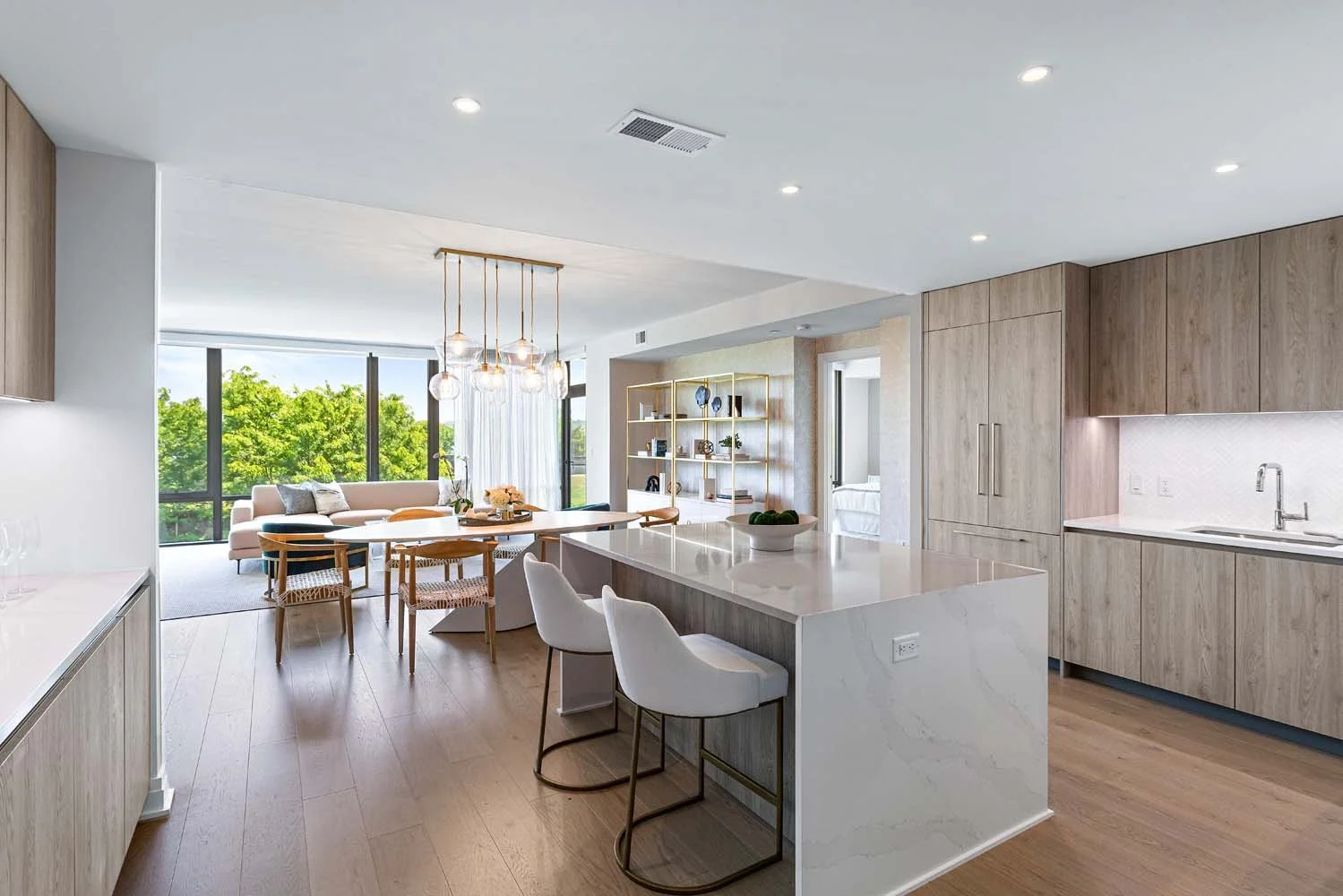
Project Development Training Manual
Inspired by Elevated Service, Connection, and Emotional Intelligence
Engagement Over Satisfaction
There is a significant difference between a satisfied client and an engaged one. In an industry increasingly dominated by transactional platforms, McWilliams|Ballard has the opportunity to lead with a more relationship-focused approach. It is not enough to simply provide answers; our goal is to create experiences where clients feel seen, understood, and valued. Engaged clients do not just buy: they remember, they refer, and they return. The emotional tone we set during the buying journey can have a lasting impact far beyond closing.
Make the Brand Story Come Alive
A compelling brand is not static — it unfolds in every interaction. Bring your community’s story to life in ways that resonate personally. Identify what makes the property special, and look for authentic, memorable ways to share that. Whether it is a unique architectural element, thoughtful amenities, or the feel of the neighborhood, connect these features to the client’s values and lifestyle. Impactful storytelling invites people to imagine themselves there—and that’s when decisions are made with both head and heart.
Everyone Deserves a Thoughtful Experience
Every person who walks through the door is an opportunity — not just for a transaction, but for a meaningful connection. Even a casual visitor or neighbor might become an advocate or future client. Be fully present during every interaction. Small moments of attentiveness, good questions, and genuine conversation can shift someone’s perception of the entire brand. This mindset transforms even routine traffic into a source of long-term value.
Design the Experience to Spark Emotion
When people remember a home, they often remember how they felt while they were there. Emotional engagement is at the core of exceptional sales interactions. Use the following principles to guide your approach:
1. Streamline the Experience
Work with your Project Manager and Developer to reduce friction points. Clear communication, a series of proactive, tailored follow-up, and expectation setting all build trust. When the process feels smooth and confident, people relax—and they begin to picture themselves as part of the community.
2. Create Defining Moments
Look for opportunities to highlight meaningful features in a way that feels personal. Instead of just describing a detail, help your client connect to it emotionally. A special finish or historical element is not just a talking point—it becomes a part of your client’s future story.
3. Use Service Awareness
Simple tactics such as using someone’s name, making eye contact, and being aware of body language build rapport quickly. A warm greeting or the right tone at the right moment creates a sense of welcome. These subtle cues speak volumes about care and professionalism.
4. Engage the Senses
Memorable environments feel layered and intentional. Use what is available to you—light, texture, scent, taste and sound—to make the space come alive. These small details, when thoughtfully chosen, elevate the atmosphere and help clients picture themselves at home.
5. Be Detail-Driven
Consistency creates credibility. When everything from the presentation of materials to contract language feels considered, clients feel secure. Developer clients notice this too—when we honor their preferences and show attention to detail, we build stronger, longer-term partnerships.
6. Offer Wisdom, Not Just Solutions
Understanding the product is important. But understanding what matters to your client—and connecting the two—is where real influence lies. It is not just knowing which way the windows face, it is knowing how that light will make someone’s morning feel better.
7. Respect Time and Tempo
Pacing matters. Move too quickly and it can feel transactional. Too slowly and it can feel unfocused. Attune to your client’s energy and match it with care. When your cadence feels calibrated to their needs, trust builds naturally.
8. Exceed Expectations, Always
When you take a moment to do something extra — something unexpected and thoughtful — it leaves a lasting impression. A small gesture, a remembered detail, a well-timed follow-up — these are the things that elevate an experience from efficient to exceptional. (Examples: Include handwritten notes, lifestyle-based updates, and personalized visuals whenever possible).
Why Connection Matters
In new-development sales and leasing, the timeline from first visit to closing is often long—and not always predictable. Delays happen. Delivery dates shift. Circumstances change. These moments—while challenging—are when the strength of your early connection becomes most valuable.
When you have taken the time to build trust, demonstrate care, and create a genuine relationship, you are better positioned to navigate tough conversations with confidence and empathy. Clients who feel supported are more likely to stay engaged, respond calmly, and work collaboratively when obstacles arise.
In short: the connections you establish early on become your most important tools later. They protect deals, preserve relationships, and safeguard reputations. They turn setbacks into moments of reassurance instead of frustration. And most importantly, they remind your clients why they chose you—and this community—in the first place.
McWilliams|Ballard Critical Path to Sales
Great salespeople understand that they are not just selling or leasing homes—they are creating an experience. Clients are not simply making a financial decision, they are imagining their next chapter. The most successful agents know how to guide that journey with empathy, consistency, and intention creating an opportunity to facilitate and opportunity for their clients to make an informed purchasing or leasing decision.
Exceptional real estate sales and leasing require more than product knowledge or smooth tours. They require the ability to connect—on a human level—with prospective clients. To listen thoughtfully, to anticipate needs, to create moments of delight, and to remain steady during times of uncertainty. Whether the timeline is short or the process extends over months or even years, the experience you deliver will be remembered, valued and shared.
This guide outlines a best-in-class approach to sales and leasing in new development anchored by the McWilliams Ballard Critical Path to Sales, our signature six-step framework for delivering exceptional results with care and consistency. Each stage emphasizes connection, emotional resonance, thoughtful detail and high-touch engagement. By integrating these principles into your daily practice, you won’t just be selling or leasing homes — you’ll be building relationships that last long after closing.
1. Onsite Presentation
The onsite presentation sets the tone for the entire experience. This is your first opportunity to signal professionalism, care, and thoughtfulness. The environment should be calm, clean, and considered. Greet every guest warmly, offer refreshments with intention, and present yourself with pride. Treat the sales gallery like a high-end retail space. Your presence, body language, and tone should reflect a sincere welcome. Small moments—like standing to greet or offering a cold drink and refreshments—go a long way in setting the tone for trust and comfort. (Refined: Stand and greet warmly as if the guest were expected. Use name where possible and offer refreshments in a calm, polished manner).
2. Qualifying
True qualifying is rooted in understanding, not interrogation. This is where emotional connection begins. Ask open-ended questions to uncover what truly matters. What does home mean to them? What are they hoping to gain or solve? Use their answers to tailor the experience—not just the product, but the tone and pacing of the presentation. Listen more than you speak. Take note of personal details. This step transforms your role from salesperson to trusted advisor.
3. Presentation of Homes
Rather than listing features, invite the client to *feel* what living here would be like. Curate your tour to highlight details that align with their values. Guide with confidence and calm, like a host revealing something special. Let them touch materials, linger in sunlit spaces, and imagine their life unfolding here. Be specific in your language—tie finishes and layouts to moments of life: morning coffee, dinner with friends, quiet evenings. Every space is a stage—your job is to light it with emotion and story.
4. Financing
Approach this topic with both clarity and sensitivity. Money is deeply emotional, and your calm confidence can turn uncertainty into reassurance. Help them understand—not just what the numbers are, but what they *mean* in the context of their life. Offer options, refer thoughtfully, and check for understanding. This is a service moment—done right, it builds trust and removes barriers. When conducting sales, always have Designated Lender materials ready—so you can provide tailored financing options that align with each client’s profile. This shows foresight, builds confidence, and empowers the client to act with clarity. Be sure to have accurate knowledge of applicable fees — HOA, move in expenses, etc so your client has a full understanding which allows them to make an informed decision.
5. Follow-Up
Follow-up is where many deals are lost—or solidified. It is not a task, it is an extension of hospitality. Every communication should feel personal and purposeful. Reference specifics from their visit, share relevant updates, and continue to provide value. Ask about their timeline, a recent trip, or something personal they shared. Use their preferred communication method and pace. A simple, sincere follow-up message can leave a stronger impression than the tour itself. Note: For prospects who register via the website, an automated responder will acknowledge their interest with a warm and professional message, setting a high-touch tone even before personal contact. (Example: Include handwritten notes, lifestyle-based updates, and personalized visuals whenever possible).
6. Overall Property Presentation
Every visible detail communicates your standard of care. A clutter-free office, aligned brochures, fresh refreshments, and clean pathways are more than logistics—they are symbols of excellence and a commitment to care. Review the entire customer-facing environment daily. Ensure the tour path is clear and beautiful. Let your setting reinforce everything you say. The goal is to create a space that feels prepared, not staged—where every element feels intentional, elevated, and never artificial.
Conclusion
You are not just selling or leasing homes. You are guiding people through a life-changing experience. Your professionalism, warmth, and attentiveness make that journey one they will remember and share. When you lead with empathy and clarity, trust follows. And trust is what closes deals, builds loyalty, and elevates careers.








